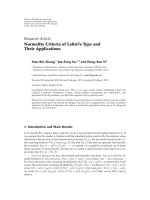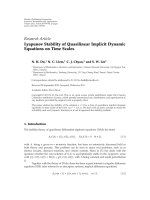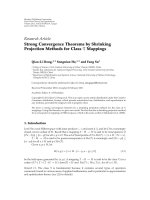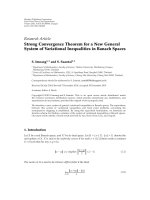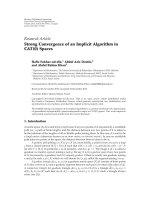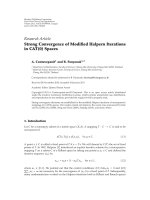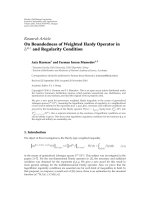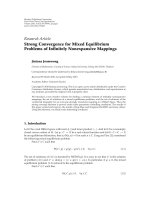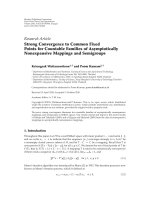Báo cáo hóa học: " Research Article Strong Convergence of an Implicit Algorithm in CAT(0) Spaces" pdf
Bạn đang xem bản rút gọn của tài liệu. Xem và tải ngay bản đầy đủ của tài liệu tại đây (511.7 KB, 11 trang )
Hindawi Publishing Corporation
Fixed Point Theory and Applications
Volume 2011, Article ID 173621, 11 pages
doi:10.1155/2011/173621
Research Article
Strong Convergence of an Implicit Algorithm in
CAT(0) Spaces
Hafiz Fukhar-ud-din,
1
Abdul Aziz Domlo,
2
and Abdul Rahim Khan
3
1
Department of Mathematics, The Islamia University of Bahawalpur, Bahawalpur 63100, Pakistan
2
Department of Mathematics, Taibah University, Madinah Munawarah 30002, Saudi Arabia
3
Department of Mathematics and Statistics, King Fahd University of Petroleum and Minerals,
Dhahran 31261, Saudi Arabia
Correspondence should be addressed to Abdul Rahim Khan,
Received 23 November 2010; Accepted 23 December 2010
Academic Editor: Qamrul Hasan Ansari
Copyright q 2011 Hafiz Fukhar-ud-din et al. This is an open access article distributed under
the Creative Commons Attribution License, which permits unrestricted use, distribution, and
reproduction in any medium, provided the original work is properly cited.
We establish strong convergence of an implicit algorithm to a common fixed point of a finite family
of generalized asymptotically quasi-nonexpansive maps in CAT0 spaces. Our work improves
and extends several recent results from the current literature.
1. Introduction
A metric space X, d is said to be a length space if any two points of X are joined by a rectifiable
path i.e., a path of finite length, and the distance between any two points of X is taken to
be the infimum of the lengths of all rectifiable paths joining them. In this case, d is said to be
a length metric otherwise known as an inner metric or intrinsic metric. In case no rectifiable
path joins two points of the space, the distance between them is taken to be ∞.
A geodesic path joining x ∈ X to y ∈ X or, more briefly, a geodesic from x to y is a map
c from a closed interval 0,l ⊂ R to X such that c0x, cly,anddct,ct
|t − t
|
for all t, t
∈ 0,l. In particular, c is an isometry, and dx, yl. The image α of c is called a
geodesic or metric segment joining x and y.WesayX is i a geodesic space if any t wo points
of X are joined by a geodesic and ii uniquely geodesic if there is exactly one geodesic joining
x and y for each x, y ∈ X, which we will denote by x, y, called the segment joining x to y.
A geodesic triangle Δx
1
,x
2
,x
3
in a geodesic metric space X, d consists of three points
in X the vertices of Δ and a geodesic segment between each pair of vertices the edges of Δ.
A comparison triangle for geodesic triangle Δx
1
,x
2
,x
3
in X, d is a triangle Δx
1
,x
2
,x
3
:
Δ
x
1
, x
2
, x
3
in R
2
such that d
R
2
x
i
, x
j
dx
i
,x
j
for i, j ∈{1, 2, 3}. Such a triangle always
exists see 1.
2 Fixed Point Theory and Applications
A geodesic metric space is said to be a CAT0 space if all geodesic triangles of
appropriate size satisfy the following CAT0 comparison axiom.
Let Δ be a geodesic triangle in X,andlet
Δ ⊂ R
2
be a comparison triangle for Δ. Then
Δ is said to satisfy the CAT0 inequality if for all x, y ∈ Δ and all comparison points
x, y ∈ Δ,
d
x, y
≤ d
x, y
. 1.1
Complete CAT0 spaces are often called Hadamard spaces see 2.Ifx, y
1
,y
2
are points of
aCAT0 space and y
0
is the midpoint of the segment y
1
,y
2
, which we will denote by
y
1
⊕ y
2
/2, then the CAT0 inequality implies
d
2
x,
y
1
⊕ y
2
2
≤
1
2
d
2
x, y
1
1
2
d
2
x, y
2
−
1
4
d
2
y
1
,y
2
. 1.2
The inequality 1.2 is the CN inequality of Bruhat and Titz 3. The above inequality has
been extended in 4 as
d
2
z, αx ⊕
1 − α
y
≤ αd
2
z, x
1 − α
d
2
z, y
− α
1 − α
d
2
x, y
,
1.3
for any α ∈ 0, 1 and x, y, z ∈ X.
Let us recall that a geodesic metric space is a CAT0 space if and only if it satisfies the (CN)
inequality see 1, page 163. Moreover, if X is a CAT0 metric space and x, y ∈ X, then for
any α ∈ 0, 1, there exists a unique point αx ⊕ 1 − αy ∈ x, y such that
d
z, αx ⊕
1 − α
y
≤ αd
z, x
1 − α
d
z, y
, 1.4
for any z ∈ X
and x, y{αx ⊕ 1 − αy : α ∈ 0, 1}.
AsubsetC of a CAT0 space X is convex if for any x, y ∈ C, we have x, y ⊂ C.
Let T be a selfmap on a nonempty subset C of X. Denote the set of fixed points of T
by FT{x ∈ C : Txx}.WesayT is: i asymptotically nonexpansive if there is a
sequence {u
n
}⊂0, ∞ with lim
n →∞
u
n
0 such that dT
n
x, T
n
y ≤ 1 u
n
dx, y for all
x, y ∈ C and n ≥ 1, ii asymptotically quasi-nonexpansive if FT
/
φ and there is a sequence
{u
n
}⊂0, ∞ with lim
n →∞
u
n
0 such that dT
n
x, p ≤ 1 u
n
dx, p for all x ∈ C, p ∈ FT
and n ≥ 1, iii generalized asymptotically quasi-nonexpansive 5 if FT
/
∅ and there exist
two sequences of real numbers {u
n
} and {c
n
} with lim
n →∞
u
n
0 lim
n →∞
c
n
such that
dT
n
x, p ≤ dx, p1 u
n
dx, pc
n
for all x ∈ C, p ∈ FT and n ≥ 1, iv uniformly
L-Lipschitzian if f or some L>0, dT
n
x, T
n
y ≤ Ldx, y for all x,y ∈ C and n ≥ 1, and v
semicompact if for any bounded sequence {x
n
} in C with dx
n
,Tx
n
→ 0asn →∞, there is
a convergent subsequence of {x
n
}.
Denote the indexing set {1, 2, 3, ,N} by I.Let{T
i
: i ∈ I} be the set of N selfmaps
of C. Throughout the paper, it is supposed that F
N
i1
FT
i
/
φ. We say condition A is
satisfied if there exists a nondecreasing function f : 0, ∞ → 0, ∞ with f00, fr > 0
for all r ∈ 0, ∞ and at least one T ∈{T
i
: i ∈ I} such that dx, Tx ≥ fdx, F for all x ∈ C
where dx, Finf{dx, p : p ∈ F}.
Fixed Point Theory and Applications 3
If in definition iii, c
n
0 for all n ≥ 1, then T becomes asymptotically quasi-
nonexpansive, and hence the class of generalized asymptotically quasi-nonexpansive maps
includes the class of asymptotically quasi-nonexpansive maps.
Let {x
n
} be a sequence in a metric space X, d,andletC be a subset of X.Wesay
that {x
n
} is: vi of monotone typeA with respect to C if for each p ∈ C, there exist two
sequences {r
n
} and {s
n
} of nonnegative real numbers such that
∞
n1
r
n
< ∞,
∞
n1
s
n
< ∞
and dx
n1
,p ≤ 1 r
n
dx
n
,ps
n
, vii of monotone typeB with respect to C if there exist
sequences {r
n
} and {s
n
} of nonnegative real numbers such that
∞
n1
r
n
< ∞,
∞
n1
s
n
< ∞
and dx
n1
,C ≤ 1 r
n
dx
n
,Cs
n
also see 6.
From the above definitions, it is clear that sequence of monotone typeA is a sequence
of monotone typeB but the converse is not true, in general.
Recently, numerous papers have appeared on the iterative approximation of fixed
points of asymptotically nonexpansive asymptotically quasi-nonexpansive maps through
Mann, Ishikawa, and implicit iterates in uniformly convex Banach spaces, convex metric
spaces and CAT0 spaces see, e.g., 5, 7–16.
Using the concept of convexity in CAT0 spaces, a generalization of Sun’s implicit
algorithm 15 is given by
x
0
∈ C,
x
1
α
1
x
0
⊕
1 − α
1
T
1
x
1
,
x
2
α
2
x
1
⊕
1 − α
2
T
2
x
2
,
.
.
.
x
N
α
N
x
N−1
⊕
1 − α
N
T
N
x
N
,
x
N1
α
N1
x
N
⊕
1 − α
N1
T
2
1
x
N1
,
.
.
.
x
2N
α
2N
x
2N−1
⊕
1 − α
2N
T
2
N
x
2N
,
x
2N1
α
2N1
x
2N
⊕
1 − α
2N1
T
3
1
x
2N1
,
.
.
.,
1.5
where 0 ≤ α
n
≤ 1.
Starting from arbitrary x
0
, the above process in the compact form is written as
x
n
α
n
x
n−1
⊕
1 − α
n
T
kn
i
n
x
n
,n≥ 1,
1.6
where n k − 1N i, i in ∈ I and k kn ≥ 1 is a positive integer such that kn →∞
as n →∞.
4 Fixed Point Theory and Applications
In a normed space, algorithm 1.6 can be written as
x
0
∈ C, x
n
α
n
x
n−1
1 − α
n
T
kn
i
n
x
n
,n≥ 1,
1.7
where n k − 1N i, i in ∈ I and k kn ≥ 1 is a positive integer such that kn →∞
as n →∞.
The algorithms 1.6-1.7 exist as follows.
Let X be a CAT0 space. Then, the following inequality holds:
d
λx ⊕
1 − λ
z, λy ⊕
1 − λ
w
≤ λd
x, y
1 − λ
d
z, w
, 1.8
for all x, y, z, w ∈ X
see 17.
Let {T
i
: i ∈ I} be the set of N uniformly L-Lipschitzian selfmaps of C.Weshowthat
1.6 exists. Let x
0
∈ C and x
1
α
1
x
0
⊕1−α
1
T
1
x
1
. Define S : C → C by: Sx α
1
x
0
⊕1−α
1
T
1
x
for all x ∈ C. The existence of x
1
is guaranteed if S has a fixed point. For any x, y ∈ C,we
have
d
Sx, Sy
≤
1 − α
1
d
T
1
x, T
1
y
≤
1 − α
1
L
x − y
. 1.9
Now, S is a contraction if 1 − α
1
L<1orL<1/1 − α
1
.Asα
1
∈ 0, 1, therefore S
is a contraction even if L>1. By the Banach contraction principle, S has a unique fixed
point. Thus, the existence of x
1
is established. Similarly, we can establish the existence of
x
2
,x
3
,x
4
, Thus, the implicit algorithm 1.6 is well defined. Similarly, we can prove that
1.7 exists.
For implicit iterates, Xu and Ori 16 proved the following theorem.
Theorem XO see 16, Theorem 2. Let {T
i
: i ∈ I} be nonexpansive selfmaps on a closed convex
subset C of a Hilbert space with F
/
φ,letx
0
∈ C, and let {α
n
} be a sequence in 0, 1 such that
lim
n →∞
α
n
0. Then, the sequence x
n
α
n
x
n−1
1 − α
n
Tx
n
,wheren ≥ 1 and T
n
T
n
mod N,
converges weakly to a point in F.
They posed the question: what conditions on the maps {T
i
: i ∈ I} and or the
parameters {α
n
} are sufficient to guarantee strong convergence of the sequence in Theorem
XO?
The aim of this paper is to study strong convergence of iterative algorithm 1.6 for
the class of uniformly L-Lipschitzian and generalized asymptotically quasi-nonexpansive
selfmaps on a CAT0 space. Thus, we provide a positive answer to Xu and Ori’s question for
the general class of maps which contains asymptotically quasi-nonexpansive, asymptotically
nonexpansive, quasi-nonexpansive, and nonexpansive maps in the setup of CAT0 spaces.
It is worth mentioning that if an implicit iteration algorithm without an error term converges,
then the method of proof generally carries over easily to algorithm with bounded error terms.
Thus, our results also hold if we add bounded error terms to the implicit iteration scheme
considered. Our results constitute generalizations of several important known results.
We need the following useful lemma for the development of our convergence results.
Fixed Point Theory and Applications 5
Lemma 1.1 see 14, Lemma 1.1. Let {r
n
} and {s
n
} be two nonnegative sequences of real
numbers, satisfying the following condition:
r
n1
≤
1 s
n
r
n
∀n ≥ n
0
for some n
0
≥ 1. 1.10
If
∞
n1
s
n
< ∞,thenlim
n →∞
r
n
exists.
2. Convergence in CAT(0) Spaces
We establish some convergence results for the algorithm 1.6 to a common fixed point of a
finite family of uniformly L-Lipschitzian and generalized asymptotically quasi-nonexpansive
selfmaps in the general class of CAT0 spaces. The following result extends Theorem XO; our
methods of proofs are based on the ideas developed in 15.
Theorem 2.1. Let X, d be a complete CAT0 space, and let C be a nonempty closed convex subset of
X.Let{T
i
: i ∈ I} be N uniformly L-Lipschitzian and generalized asymptotically quasi-nonexpansive
selfmaps of C with {u
in
}, {c
in
}⊂0, ∞ such that
∞
n1
u
in
< ∞ and
∞
n1
c
in
< ∞ for all i ∈ I.
Suppose that F is closed. Starting from arbitrary x
0
∈ C, define the sequence {x
n
} by the algorithm
1.6,where{α
n
}⊂δ, 1−δ for some δ ∈ 0, 1/2. Then, {x
n
} is of monotone type(A) and monotone
type(B) with respect to F. Moreover, {x
n
} converges strongly to a common fixed point of the maps
{T
i
: i ∈ I} if and only if lim inf
n →∞
dx
n
,F0.
Proof. First, we show that {x
n
} is of monotone type(A) and monotone type(B) with respect to F.Let
p ∈ F. Then, from 1.6,weobtainthat
d
x
n
,p
d
α
n
x
n−1
⊕
1 − α
n
T
kn
i
n
x
n
,p
≤ α
n
d
x
n−1
,p
1 − α
n
d
T
kn
i
n
x
n
,p
≤ α
n
d
x
n−1
,p
1 − α
n
d
x
n
,p
u
ikn
d
x
n
,p
c
ikn
≤ α
n
d
x
n−1
,p
1 − α
n
u
ikn
d
x
n
,p
1 − α
n
c
ikn
.
2.1
Since α
n
∈ δ, 1 − δ, the above inequlaity gives that
d
x
n
,p
≤ d
x
n−1
,p
u
ikn
δ
d
x
n
,p
1
δ
− 1
c
ikn
. 2.2
On simplification, we have that
d
x
n
,p
≤
δ
δ − u
ikn
d
x
n−1
,p
1
δ
− 1
δ
δ − u
ikn
c
ikn
.
2.3
Let 1 v
ikn
δ/δ − u
ikn
1 u
ikn
/δ − u
ikn
and γ
ikn
1/δ − 11 v
ikn
c
ikn
.
Since
∞
kn1
u
ikn
< ∞ for all i ∈ I, therefore lim
kn →∞
u
ikn
0, and hence, there exists a
6 Fixed Point Theory and Applications
natural number n
1
such that u
ikn
<δ/2forkn ≥ n
1
/N 1orn>n
1
. Then, we have that
∞
kn1
v
ikn
< 2/δ
∞
kn1
u
ikn
< ∞. Similarly,
∞
kn1
γ
ikn
< ∞.
Now, from 2.3,forkn ≥ n
1
/N 1, we get that
d
x
n
,p
≤
1 v
ikn
d
x
n−1
,p
γ
ikn
, 2.4
d
x
n
,F
≤
1 v
ikn
d
x
n−1
,F
γ
ikn
. 2.5
These inequalities, respectively, prove that {x
n
} is a sequence of monotone typeA and
monotone typeB with respect to F.
Next, we prove that {x
n
} converges strongly to a common fixed point of the maps
{T
i
: i ∈ I} if and only if lim inf
n →∞
dx
n
,F0.
If x
n
→ p ∈ F, then lim
n →∞
dx
n
,p0. Since 0 ≤ dx
n
,F ≤ dx
n
,p, we have
lim inf
n →∞
dx
n
,F0.
Conversely, suppose that lim inf
n →∞
dx
n
,F0. Applying Lemma 1.1 to 2.5,we
have that lim
n →∞
dx
n
,F exists. Further, by assumption lim inf
n →∞
dx
n
,F0, we conclude
that lim
n →∞
dx
n
,F0. Next, we show that {x
n
} is a Cauchy sequence.
Since x ≤ expx − 1 for x ≥ 1, therefore from 2.4, we have
d
x
nm
,p
≤ exp
⎛
⎝
N
i1
∞
k
n
1
v
ikn
⎞
⎠
d
x
n
,p
N
i1
∞
k
n
1
γ
ikn
<Md
x
n
,p
N
i1
∞
k
n
1
γ
ikn
,
2.6
for the natural numbers m, n, where M exp{
N
i1
∞
kn1
v
ikn
} 1 < ∞. Since
lim
n →∞
dx
n
,F0, therefore for any >0, there exists a natural number n
0
such that
dx
n
,F </4M and
N
i1
∞
jn
γ
ij
≤ /4 for all n ≥ n
0
. So, we can find p
∗
∈ F such that
dx
n
0
,p
∗
≤ /4M. Hence, for all n ≥ n
0
and m ≥ 1, we have that
d
x
nm
,x
n
≤ d
x
nm
,p
∗
d
x
n
,p
∗
<Md
x
n
0
,p
∗
N
i1
∞
jn
0
γ
ij
Md
x
n
0
,p
∗
N
i1
∞
jn
0
γ
ij
2
⎛
⎝
Md
x
n
0
,p
∗
N
i1
∞
jn
0
γ
ij
Md
x
n
0
,p
∗
⎞
⎠
≤ 2
M
4M
4
.
2.7
This proves that {x
n
} is a Cauchy sequence. Let lim
n →∞
x
n
z. Since C is closed, therefore
z ∈ C. Next, we show that z ∈ F. Now, the following two inequalities:
d
z, p
≤ d
z, x
n
d
x
n
,p
∀p ∈ F, n ≥ 1,
d
z, x
n
≤ d
z, p
d
x
n
,p
∀p ∈ F, n ≥ 1
2.8
Fixed Point Theory and Applications 7
give that
−d
z, x
n
≤ d
z, F
− d
x
n
,F
≤ d
z, x
n
,n≥ 1. 2.9
That is,
|
d
z, F
− d
x
n
,F
|
≤ d
z, x
n
,n≥ 1. 2.10
As lim
n →∞
x
n
z and lim
n →∞
dx
n
,F0, we conclude that z ∈ F.
We deduce some results from Theorem 2.1 as follows.
Corollary 2.2. Let X, d be a complete CAT0 space, and let C be a nonempty closed convex
subset of X.Let{T
i
: i ∈ I} be N uniformly L-Lipschitzian and generalized asymptotically quasi-
nonexpansive selfmaps of C with {u
in
}, {c
in
}⊂0, ∞ such that
∞
n1
u
in
< ∞ and
∞
n1
c
in
< ∞
for all i ∈ I. Suppose that F is closed. Starting from arbitaray x
0
∈ C, define the sequence {x
n
} by the
algorithm 1.6,where{α
n
}⊂δ, 1 − δ for some δ ∈ 0, 1/2. Then, {x
n
} converges strongly to a
common fixed point of the maps {T
i
: i ∈ I} if and only if there exists some subsequence {x
n
j
} of {x
n
}
which converges to p ∈ F.
Corollary 2.3. Let X, d be a complete CAT0 space, and let C be a nonempty closed convex subset
of X.Let{T
i
: i ∈ I} be N uniformly L-Lipschitzian and asymptotically quasi-nonexpansive selfmaps
of C with {u
in
}⊂0, ∞ such that
∞
n1
u
in
< ∞ for all i ∈ I. Starting from arbitaray x
0
∈ C, define
the sequence {x
n
} by the algorithm 1.6,where{α
n
}⊂δ, 1 − δ for some δ ∈ 0, 1/2. Then, {x
n
}
is of monotone type(A) and monotone type(B) with respect to F. Moreover, {x
n
} converges strongly to
a common fixed point of the maps {T
i
: i ∈ I} if and only if lim inf
n →∞
dx
n
,F0.
Proof. Follows from Theorem 2.1 with c
in
0 for all n ≥ 1.
Corollary 2.4. Let X be a Banach space, and let C be a nonempty closed convex subset of X.Let
{T
i
: i ∈ I} be N asymptotically quasi-nonexpansive self-maps of C with {u
in
}⊂0, ∞ such that
∞
n1
u
in
< ∞ for all i ∈ I. Starting from arbitaray x
0
∈ C, define the sequence {x
n
} by the algorithm
1.7,where{α
n
}⊂δ, 1−δ for some δ ∈ 0, 1/2. Then, {x
n
} is of monotone type(A) and monotone
type(B) with respect to F. Moreover, {x
n
} converges strongly to a common fixed point of the maps
{T
i
: i ∈ I} if and only if lim inf
n →∞
dx
n
,F0.
Proof. Take λx ⊕ 1 − λy λx 1 − λy in Corollary 2.3.
The lemma to follow establishes an approximate sequence, and as a consequence of
that, we find another strong convergence theorem for 1.6.
Lemma 2.5. Let X, d be a complete CAT0 space, and let C be a nonempty closed convex subset of
X.Let{T
i
: i ∈ I} be N uniformly L-Lipschitzian and generalized asymptotically quasi-nonexpansive
selfmaps of C with {u
in
}, {c
in
}⊂0, ∞ such that
∞
n1
u
in
< ∞ and
∞
n1
c
in
< ∞ for all i ∈ I.
Suppose that F is closed. Let {α
n
}⊂δ, 1 − δ for some δ ∈ 0, 1/2. From arbitaray x
0
∈ C, define
the sequence {x
n
} by 1.6. Then, lim
n →∞
dx
n
,T
l
x
n
0 for all i ∈ I.
8 Fixed Point Theory and Applications
Proof. Note that {x
n
} is bounded as lim
n →∞
dx
n
,p exists proved in Theorem 2.1. So, there
exists R>0andx
0
∈ X such that x
n
∈ B
R
x
0
{x : dx, x
0
<R} for all n ≥ 1. Denote
dx
n−1
,T
kn
in
x
n
by σ
n
.
We claim that lim
n →∞
σ
n
0.
For any p ∈ F, apply 1.3 to 1.6 and get
d
2
x
n
,p
d
2
α
n
x
n−1
⊕
1 − α
n
T
kn
i
n
x
n
,p
≤ α
n
d
2
x
n−1
,p
1 − α
n
1 u
ikn
d
x
n
,p
c
ikn
2
− α
n
1 − α
n
d
2
T
kn
i
n
x
n
,x
n−1
2.11
further, using 2.4,weobtain
2δ
3
σ
2
n
≤ α
n
d
2
x
n−1
,x
∗
− d
2
x
n
,x
∗
1 − α
n
1 u
ikn
1 v
ikn
d
x
n−1
,x
∗
1 u
ikn
γ
ikn
c
ikn
2
,
2.12
which implies that
2δ
3
σ
2
n
≤ α
n
d
2
x
n−1
,p
1 − α
n
d
2
x
n−1
,p
u
ikn
v
ikn
γ
ikn
c
ikn
M − d
2
x
n
,p
,
2.13
for some consant M>0. This gives that
2δ
3
σ
2
n
≤ d
2
x
n−1
,p
− d
2
x
n
,p
σ
ikn
M,
2.14
where σ
ikn
u
ikn
v
ikn
γ
ikn
c
ikn
.
For m ≥ 1, we have that
2δ
3
m
n1
σ
2
n
≤ d
2
x
0
,p
− d
2
x
m
,p
m
k
n
1
σ
ikn
M
≤ d
2
x
0
,p
m
k
n
1
σ
ikn
M.
2.15
When m →∞, we have that
∞
n1
σ
2
n
< ∞ as
∞
kn1
σ
ikn
< ∞.
Hence,
lim
n →∞
σ
n
0.
2.16
Fixed Point Theory and Applications 9
Further,
d
x
n
,x
n−1
≤
1 − α
n
d
T
kn
i
n
x
n
,x
n−1
1 − α
n
σ
n
≤
1 − δ
σ
n
2.17
implies that lim
n →∞
dx
n
,x
n−1
0.
For a fixed j ∈ I, we have dx
nj
,x
n
≤ dx
nj
,x
nj−1
··· dx
n
,x
n−1
, and hence
lim
n →∞
d
x
nj
,x
n
0 ∀j ∈ I.
2.18
For n>N, n n − Nmod N.Also,n kn − 1N in. Hence, n − N kn − 1 −
1N inkn − NN in − N.
That is, kn − Nkn − 1andin − Nin.
Therefore, we have
d
x
n−1
,T
n
x
n
≤ d
x
n−1
,T
kn
i
n
x
n
d
T
kn
i
n
x
n
,Tx
n
≤ σ
n
Ld
T
kn−1
i
n
x
n
,x
n
≤ σ
n
L
2
d
x
n
,x
n−N
Ld
T
kn−N
i
n−N
x
n−N
,x
n−N−1
Ld
x
n−N−1
,x
n
σ
n
L
2
d
x
n
,x
n−N
Lσ
n−N
Ld
x
n−N−1
,x
n
,
2.19
which together with 2.16 and 2.18 yields that lim
n →∞
dx
n−1
,Tx
n
0.
Since
d
x
n
,Tx
n
≤ d
x
n
,x
n−1
d
x
n−1
,T
n
x
n
, 2.20
we have
lim
n →∞
d
x
n
,T
n
x
n
0.
2.21
Hence, for all l ∈ I,
d
x
n
,T
nl
x
n
≤ d
x
n
,x
nl
d
x
nl
,T
nl
x
nl
d
T
nl
x
nl
,T
nl
x
n
≤
1 L
d
x
n
,x
nl
d
x
nl
,T
nl
x
nl
,
2.22
together with 2.18 and 2.21 implies that
lim
n →∞
d
x
n
,T
nl
x
n
0 ∀l ∈ I.
2.23
Thus, lim
n →∞
dx
n
,T
l
x
n
0 for all l ∈ I.
10 Fixed Point Theory and Applications
Theorem 2.6. Let X, d be a complete CAT0 space, and let C be a nonempty closed convex subset of
X.Let{T
i
: i ∈ I} be N-uniformly L-Lipschitzian and generalized asymptotically quasi-nonexpansive
selfmaps of C with {u
in
}, {c
in
}⊂0, ∞ such that
∞
n1
u
in
< ∞ and
∞
n1
c
in
< ∞ for all i ∈ I.
Suppose that F is closed, and there exists one member T in {T
i
: i ∈ I} which is either semicompact or
satisfies condition (A). Let {α
n
}⊂δ, 1 − δ for some δ ∈ 0, 1/2. From arbitaray x
0
∈ C, define the
sequence {x
n
} by algorithm 1.6. Then, {x
n
} converges strongly to a common fixed point of the maps
in {T
i
: i ∈ I}.
Proof. Without loss of generality, we may assume that T
1
is either semicompact or satisfies
condition A.IfT
1
is semicompact, then there exists a subsequence {x
n
j
} of {x
n
} such that
x
n
j
→ x
∗
∈ C as j →∞.Now,Lemma 2.5 guarantees that lim
n →∞
dx
n
j
,T
l
x
n
j
0 for all l ∈ I
and so dx
∗
,T
l
x
∗
0 for all l ∈ I. This implies that x
∗
∈ F. Therefore, lim inf
n →∞
dx
n
,F0.
If T
1
satisfies condition A, then we also have lim inf
n →∞
dx
n
,F0. Now, Theorem 2.1
gaurantees that {x
n
} converges strongly to a point in F.
Finally, we state two corollaries to the above theorem.
Corollary 2.7. Let X, d be a complete CAT0 space and let C be a nonempty closed convex subset
of X.Let{T
i
: i ∈ I} be N uniformly L-Lipschizian and asymptotically quasi-nonexpansive selfmaps
of C with {u
in
}⊂0, ∞ such that
∞
n1
u
in
< ∞ for all i ∈ I. Suppose that there exists one member
T in {T
i
: i ∈ I} which is either semicompact or satisfies condition (A). From arbitaray x
0
∈ C, define
the sequence {x
n
} by algorithm 1.6,where{α
n
}⊂δ, 1 − δ for some δ ∈ 0, 1/2. Then, {x
n
}
converges strongly to a common fixed point of the maps in {T
i
: i ∈ I}.
Corollary 2.8. Let X, d be a complete CAT0 space, and let C be a nonempty closed convex subset
of X.Let{T
i
: i ∈ I} be N asymptotically nonexpansive selfmaps of C with {u
in
}⊂0, ∞ such that
∞
n1
u
in
< ∞ for all i ∈ I. Suppose that there exists one member T in {T
i
: i ∈ I} which is either
semicompact or satisfies condition (A). From arbitrary x
0
∈ C, define the sequence {x
n
} by algorithm
1.6,where{α
n
}⊂δ, 1 − δ for some δ ∈ 0, 1. Then, {x
n
} converges strongly to a common fixed
point of the maps in {T
i
: i ∈ I}.
Remark 2.9. The corresponding approximation results for a finite family of asymptotically
quasi-nonexpansive maps on: i uniformly convex Banach spaces 5, 14, 15, ii convex
metric spaces 13, iii CAT0 spaces 12 are immediate consequences of our results.
Remark 2.10. Various algorithms and their strong convergence play an important role in
finding a common element of the set of fixed common fixed point for different classes of
mappings and the set of solutions of an equilibrium problem in the framework of Hilbert
spaces and Banach spaces; for details we refer to 18–20.
Acknowledgments
The author A. R. Khan gratefully acknowledges King Fahd University of Petroleum and
Minerals and SABIC for supporting research project no. SB100012.
References
1 M. R. Bridson and A. Haefliger, Metric Spaces of Non-Positive Curvature, vol. 319 of Grundlehren der
Mathematischen Wissenschaften, Springer, Berlin, Germany, 1999.
Fixed Point Theory and Applications 11
2 M. A. Khamsi and W. A. Kirk, An Introduction to Metric Spaces and Fixed Point Theory, Pure and Applied
Mathematics, Wiley-Interscience, New York, NY, USA, 2001.
3 F. Bruhat and J. Tits, “Groupes r
´
eductifs sur un corps local,” Institut des Hautes
´
Etudes Scientifiques.
Publications Math
´
ematiques, no. 41, pp. 5–251, 1972.
4 S. Dhompongsa and B. Panyanak, “On Δ-convergence theorems in CAT0 spaces,” Computers &
Mathematics with Applications, vol. 56, no. 10, pp. 2572–2579, 2008.
5 S. Imnang and S. Suantai, “Common fixed points of multistep Noor iterations with errors for a finite
family of generalized asymptotically quasi-nonexpansive mappings,” Abstract and Applied Analysis,
vol. 2009, Article ID 728510, 14 pages, 2009.
6 H. Y. Zhou, G. L. Gao, G. T. Guo, and Y. J. Cho, “Some general convergence principles with
applications,” Bulletin of the Korean Mathematical Society, vol. 40, no. 3, pp. 351–363, 2003.
7 H. Fukhar-ud-din and A. R. Khan, “Approximating common fixed points of asymptotically
nonexpansive maps in uniformly convex Banach spaces,” Computers & Mathematics with Applications,
vol. 53, no. 9, pp. 1349–1360, 2007.
8 H. Fukhar-ud-din and A. R. Khan, “Convergence of implicit iterates with errors for mappings with
unbounded domain in Banach spaces,” International Journal of Mathematics and Mathematical Sciences,
no. 10, pp. 1643–1653, 2005.
9 H. Fukhar-ud-din, A. R. Khan, D. O’Regan, and R. P. Agarwal, “An implicit iteration scheme with
errors for a finite family of uniformly continuous mappings,” Functional Differential Equations, vol. 14,
no. 2–4, pp. 245–256, 2007.
10 H. Fukhar-ud-din and S. H. Khan, “Convergence of iterates with errors of asymptotically quasi-
nonexpansive mappings and applications,” Journal of Mathematical Analysis and Applications, vol. 328,
no. 2, pp. 821–829, 2007.
11 W. Guo and Y. J. Cho, “On the strong convergence of the implicit iterative processes with errors for a
finite family of asymptotically nonexpansive mappings,” Applied Mathematics Letters, vol. 21, no. 10,
pp. 1046–1052, 2008.
12 A. R. Khan, M. A. Khamsi, and H. Fukhar-ud-din, “Strong convergence of a general iteration scheme
in CAT0 spaces,” Nonlinear Analysis: Theory, Methods and Applications, vol. 74, no. 3, pp. 783–791,
2011.
13 A. R. Khan and M. A. Ahmed, “Convergence of a general iterative scheme for a finite family of
asymptotically quasi-nonexpansive mappings in convex metric spaces and applications,” Computers
& Mathematics with Applications, vol. 59, no. 8, pp. 2990–2995, 2010.
14 A. R. Khan, A A. Domlo, and H. Fukhar-ud-din, “Common fixed points Noor iteration for a finite
family of asymptotically quasi-nonexpansive mappings in Banach spaces,” Journal of Mathematical
Analysis and Applications, vol. 341, no. 1, pp. 1–11, 2008.
15 Z. Sun, “Strong convergence of an implicit iteration process for a finite family of asymptotically quasi-
nonexpansive mappings,” Journal of Mathematical Analysis and Applications, vol. 286, no. 1, pp. 351–358,
2003.
16 H K. Xu and R. G. Ori, “An implicit iteration process for nonexpansive mappings,” Numerical
Functional Analysis and Optimization, vol. 22, no. 5-6, pp. 767–773, 2001.
17 L. Leustean, “A quadratic rate of asymptotic regularity for CAT0-spaces,” Journal of Mathematical
Analysis and Applications, vol. 325, no. 1, pp. 386–399, 2007.
18 A. Tada and W. Takahashi, “Weak and strong convergence theorems for a nonexpansive mapping and
an equilibrium problem,” Journal of Optimization Theory and Applications, vol. 133, pp. 359–370, 2007.
19 L C. Ceng, S. Al-Homidan, Q. H. Ansari, and J C. Yao, “An iterative scheme for equilibrium
problems and fixed point problems of strict pseudo-contraction mappings,” Journal of Computational
and Applied Mathematics, vol. 223, pp. 967–974, 2009.
20 X. Qin, Y. J. Cho, and S. M. Kang, “Convergence theorems of common elements for equilibrium
problems and fixed point problems in Banach spaces,” Journal of Computational and Applied
Mathematics, vol. 225, pp. 20–30, 2009.
